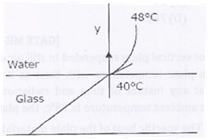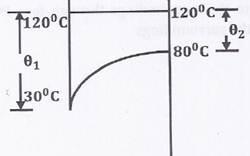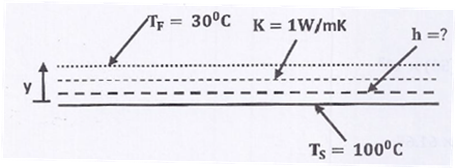Solved GATE Questions on Convection
Question 1. Water (Prandtl ) flows over a flat plate which is heated over the entire length. Which one of the following relationship between the hydrodynamic boundary layer thickness (
) flows over a flat plate which is heated over the entire length. Which one of the following relationship between the hydrodynamic boundary layer thickness ( ) and the thermal boundary layer thickness (
) and the thermal boundary layer thickness ( ) is true?
) is true?
(A) 
(B) 
(C) 
(D) Cannot be predicted
GATE-ME-2001
Hint 1. (Ans B)

Here, 


Question 2. The properties of mercury at 300 K are : density=13529  , specific heat at constant pressure =0.1393 kJ/kg-K, dynamic viscosity=0.1523
, specific heat at constant pressure =0.1393 kJ/kg-K, dynamic viscosity=0.1523 and thermal conductivity=8.540
and thermal conductivity=8.540  . The Prandtlnumber of the mercury at 300 K is
. The Prandtlnumber of the mercury at 300 K is
(A) 0.0248
(B) 2.48
(C) 24.8
(D) 248
GATE-ME-2002
Hint 2. (Ans A)
Prandtl number 


Data for Question 3-4 are given below. Solve the problems and choose correct answers.
Heat is being transferred by convection from water at 48  to a glass plate whose surface that is exposed to the water is 40
to a glass plate whose surface that is exposed to the water is 40 . The thermal conductivity of water is 0.6 W/m K and the thermal conductivity of glass is 1.2 W/m K. The spatial gradient of temperature in the water –glass is 1.2 W/mK. The spatial gradient of temperature in the water –glass interface is
. The thermal conductivity of water is 0.6 W/m K and the thermal conductivity of glass is 1.2 W/m K. The spatial gradient of temperature in the water –glass is 1.2 W/mK. The spatial gradient of temperature in the water –glass interface is 

Question 3. The value of the temperature gradient in the glass at the water –glass interface in K/m is
(A) 
(B) 0.0
(C) 
(D) 
GATE-ME-2003
Hint 3. Ans (C)
Temperature of water 
Temperature of glass plate
Thermal conductivity of water 
Thermal conductivity of glass
The spatial gradient of temperature in water at the water glass interface 





Question 4. The heat transfer coefficient h in  is
is
(A) 0.0
(B) 4.8
(C) 6
(D) 750
GATE-ME-2003
Hint 4. (Ans D)
For convection
Heat flux, 


Question 5. In a condenser, water enters at 30 and flows at the rate 1500 kg/hr. The condensing steam is at a temperature of 120
and flows at the rate 1500 kg/hr. The condensing steam is at a temperature of 120 and cooling water leaves the condenser at 80
and cooling water leaves the condenser at 80 . Specific heat of water is 4.187 kJ/kg K. If the overall heat transfer coefficient is 2000
. Specific heat of water is 4.187 kJ/kg K. If the overall heat transfer coefficient is 2000  , then heat transfer area is
, then heat transfer area is
(A) 0.707 
(B) 7.07 
(C) 70.7 
(D) 141.7 
GATE-ME-2004
Hint 5. (Ans A)
Here 

Log mean temperature difference





Again 

 5
5
Statement for Linked Answer Questions 6 and 7:
An un-insulated air conditioning duct of rectangular cross section 1m 0.5 m, carrying air at 20
0.5 m, carrying air at 20 with a velocity of 10 m/s, is exposed to an ambient air of 30
with a velocity of 10 m/s, is exposed to an ambient air of 30 . Neglect the effect of duct construction material. For air in the range of 20-30
. Neglect the effect of duct construction material. For air in the range of 20-30 , data are as follows: thermal conductivity =0.025 W/m K ; velocity 18
, data are as follows: thermal conductivity =0.025 W/m K ; velocity 18  ; Prandtl number=0.73 ; density=1.2
; Prandtl number=0.73 ; density=1.2  .the laminar flow Nusselt number is 3.4 for constant wall temperature conditions and, for turbulent flow, Nu=0.023
.the laminar flow Nusselt number is 3.4 for constant wall temperature conditions and, for turbulent flow, Nu=0.023
Question 6. The Reynolds number for the flow is
(A) 444
(B) 890
(C) 4.44
(D) 5.33
GATE-ME-2005
Hint 6. (Ans C)




Question 7. The heat transfer per metre length of the duct, in watts, is
(A) 3.8
(B) 5.3
(C) 89
(D) 769
GATE-ME-2005
Hint 7. (Ans D)
Because  , the flow is turbulent
, the flow is turbulent




Heat transfer per metre length of duct



Question 8. The average heat transfer coefficient on a thin hot vertical plate suspended in still air can be determined from observations of the change in plate temperature with time as it cools. Assume the plate temperature is uniform at any instant of time and radiation heat exchange with the surroundings is negligible. The ambient temperature is 25 , the plate has a total surface area of 0.1
, the plate has a total surface area of 0.1 and a mass of 4 kg. The specific heat of the plate material is 2.5 KJ/kg K. The convective heat transfer coefficient in
and a mass of 4 kg. The specific heat of the plate material is 2.5 KJ/kg K. The convective heat transfer coefficient in  , at the instant when the plate temperature is 225
, at the instant when the plate temperature is 225 and the change in plate temperature with time
and the change in plate temperature with time  , is
, is
(A) 200
(B) 20
(C) 15
(D) 10
GATE-ME-2007
Hint 8. (Ans D)
From heat balance equation,

Where  =Ambient temperature
=Ambient temperature

Question 9. The temperature distribution within the thermal boundary layer over a heated isothermal flat plate is given by  , where
, where  are the temperatures of free stream and plate respectively, and y is the normal distance measured from the plate. The local Nusselt stream based on the thermal boundary layer thickness
are the temperatures of free stream and plate respectively, and y is the normal distance measured from the plate. The local Nusselt stream based on the thermal boundary layer thickness  is given by
is given by
(A) 1.33
(B) 1.50
(C) 2.0
(D) 4.64
GATE-ME-2007
Hint 9.(Ans B)
Only (B) satisfies the condition.
Question 10. For the three-dimensional object shown in the figure below, five faces are insulated. The sixth face (PQRS), which is not insulated, interacts thermally with the ambient, with a convective heat transfer coefficient of 10  . The ambient temperature is 30
. The ambient temperature is 30 . Heat is uniformly generated inside the object at the rate of 100
. Heat is uniformly generated inside the object at the rate of 100  . Assuming the face PQRS to be at uniform temperature, its steady state temperature is
. Assuming the face PQRS to be at uniform temperature, its steady state temperature is

(A) 10
(B) 20
(C) 30
(D) 40
GATE-ME-2008
Hint 10. (Ans D)
Since the heat would be flowing from the block to the surroundings through face PQRS, hence heat would decrease from centre to PQRS to the surroundings.


Question 11. For flow of fluid over a heated plate, the following fluid properties are known
Viscosity=0.01 Pa.s ; specific heat at constant pressure =1 kJ/kg K;
Thermal conductivity=1 W/m K.
The hydrodynamic boundary layer thickness at specified location on the plate is 1 mm. the thermal boundary layer thickness at the same location is
(A) 0.001 mm
(B) 0.01 mm
(C) 1 mm
(D) 1000 mm
GATE-ME-2008
Hint 11. (Ans C)
Question 12. A coolant fluid at 30 flows over a heated flat plate maintained at a constant temperature of 100
flows over a heated flat plate maintained at a constant temperature of 100 . The boundary layer temperature distribution at a given location on the plate may be approximated as
. The boundary layer temperature distribution at a given location on the plate may be approximated as  where (y) (in m) is the distance normal to the plate and T is in
where (y) (in m) is the distance normal to the plate and T is in  . If thermal conductivity of the is 1.0 mK, the local convective heat transfer coefficient (
. If thermal conductivity of the is 1.0 mK, the local convective heat transfer coefficient ( ) at that location will be
) at that location will be
(A) 0.2
(B) 1
(C) 5
(D) 10
GATE-ME-2009
Hint 12. (Ans B)

Under steady state conditions
Heat transfer by conduction=Heat transfer by convection




But y=0




Alternatively



Answer keys
1.(B) 2. (A) 3. (C) 4. (D) 5. (A) 6. (C) 7. (D) 8.(D) 9.(B) 10.(D) 11.(C) 12. (B)
One Response to “Previous Years GATE Questions on Convection”
Leon
Previous year papers of GATE Computer Science and Engineering, Solutions, Explanations.